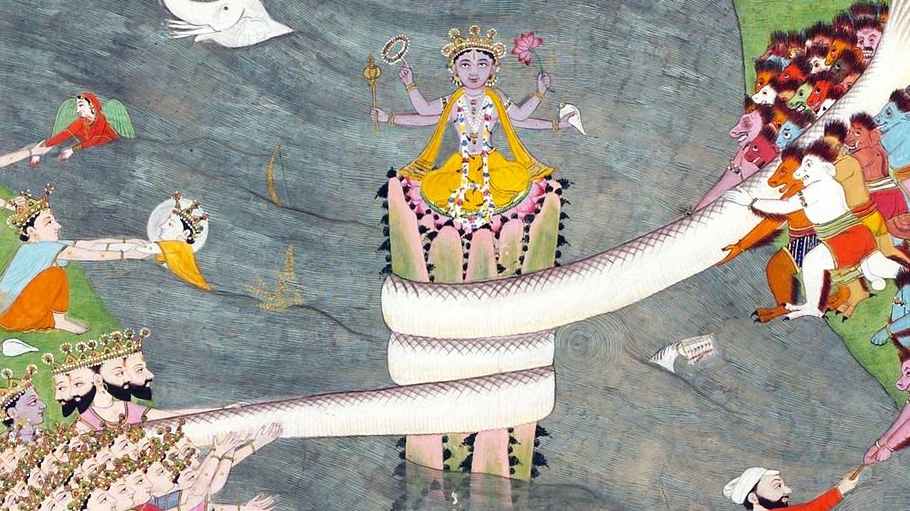We use cookies to optimise our website functionality and give you the best experience possible. Please, accept our Terms and Conditions. ACCEPT
Dhanvantari, an incarnation of the God Vishnu, the immanent Divine consciousness, represents Divine healer in the tradition of ayurveda. To Heal ourselves we must set this Divine healer in motion within ourselves.
Ayurveda is a spiritual science in itself. It is believed that Ayurveda, as a branch of the Vedas, is a stream of the knowledge passed down from generation to generation since eternity, much in the same way as Vedic literature and the Vedic scriptures were. As the story goes, the knowledge of Ayurveda was created by Brahma, the Creator, who gave it to Prajapati, who passed it to the Ashwini Kumari (the celestial Twin Physicians), who in turn passed it down to Indra, and so on.
According to the Charaka Samhita, the knowledge of Ayurveda is eternal and is revealed in each of the cycles of creation of the universe. When needed, Lord Vishnu himself incarnates as Lord Dhanvantari and reestablishes the tradition of Ayurveda in the world to help relieve some of humanity’s suffering.
"Dhanvantari, an incarnation of the God Vishnu, represents this truth in the tradition of Ayurveda. It is a reminder that however much we know or skillfull we become, everything still depends on the grace of spiritual nature. This knowledge is dedicated to the divine healer within you." David Frawley
Lord Dhanvantari is known as the father of Ayurveda, since he was the first divine incarnation to impart its wisdom amongst humans. He first appeared during the great churning of the cosmic ocean of milk (The Samudra Manthan) to deliver amrita (Divine nectar) to the demigods. The churning of the ocean of milk is a famous episode in the Puranas that represents the spiritual endeavor of a person to achieve self-realization through concentration of mind, withdrawal of the senses, control of all desires, austerities and asceticism. It is celebrated in India every twelve years in the holy festival known as Kumbha Mela.
 ©
UNKNOWN
©
UNKNOWN
Using the mountain Mandara as the rod and Vasuki the serpent as the cord, both demigods and demons proceeded to churn the ocean of milk. All kinds of herbs were cast into it. The churning was so arduous that Lord Vishnu had to appear in many forms to help them with this process and prevent it from going nowhere. He even appeared as Lord Vishnu himself sitting on top of the mountain to infuse Indra and his companions with energy.
The churning of the ocean of milk first produced a deadly poison (halahala) that only Lord Shiva could swallow without being affected by it. And so he did, except that his consort Parvati pressed his neck as he was swallowing, so that the poison would not reach his stomach, and the halahala stayed in Lord Shiva’s throat, changing the color of his neck to blue due to its potency. This is why Lord Shiva is also called Neelakantha, or the blue-necked one.
During the churning, many Divine objects and beings emerged from the ocean, including Kamadhenu (the wish fulfilling cow), Ucchaisrava (the white horse), Airavata (the white elephant), Kaustubhamani (a rare diamond), Kalpavriksha (the wish fulfilling tree), and Shri Lakshmi, the Goddess of Wealth, who after being worshipped by all Gods, demigods, asuras and everyone else present, was reunited with her husband Lord Vishnu after having been separated for many ages.
As the churning continued, Lord Dhanvantari appeared. He was young and strongly built, his chest was very broad and his complexion bluish black. He had strong arms, reddish eyes, and moved like a lion. He was clad in bright yellow, his curly hair was anointed with oil and he wore shining earrings made of pearl. As he emerged, he was holding a conch, leeches, healing herbs, a chakra (one of the divine weapons of Lord Vishnu’s), and the long sought pot of ambrosia, for which he is also called Sudha Pani (carrying nectar). The asuras, greedy after all things, realized right away that the container was full of nectar and snatched it from him.
Again filled with greed and pride, the demons started quarreling about which of them would drink the nectar first, grabbing the pot from one another and behaving like thieves. Seeing how busy they were fighting with each other, Lord Vishnu didn't miss the opportunity to trick them. He appeared as Mohini, a beautiful woman who fascinated the demons, recovered the nectar from them, and distributed it only amongst the demigods. As soon as the demigods drank it, they were invigorated with energy and defeated the demons. After worshipping Lord Vishnu and Shri Laxmi, they resumed their position in the heavens.
At the time of the churning, Lord Vishnu foretold that Lord Dhanvantari would appear again in the world to teach men the science of Ayurveda. And so he did, after Lord Indra, seeing humanity so afflicted by pain and disease, pleaded with Lord Dhanvantari to descend into the material world and teach Ayurveda to the human race.
The word dhanus is only indicative (upalakshna). It denotes the science of surgery. The one who has seen the end (anta) of it is Dhanvantari.
The word dhanvan means desert. (Compare RigVeda [V.36.1] dhanvachara meaning, he who moves in a desert). There is a mantra in the Veda: Dhanvan Iva Prapaasi (O Lord! You are like the place where water is distributed to travellers in a desert.) Thus Dhanvantari, the incarnation of Lord Vishnu, with a pot of nectar in his hand is like prapaa (oasis) in the desert of worldly existence.
Lord Dhanvantari is an outstanding personality in the history of Ayurveda. He was the physician of the Gods (in both the Vedas and Puranas) and an excellent surgeon. In Hinduism, worshipers pray to Dhanvantari seeking his blessings for sound healing. In his incarnation as king of Kashi, Divodasa, he was approached by a group of sages (including Susruta, the great Indian surgeon) with the request to teach them the science of Ayurveda. Dhanvantari stated that Brahma composed the Ayurveda even before he created mankind, forming one of the upangas of the Atharvaveda in 100,000 verses arranged in 1,000 chapters, which was not easy for the restricted intelligence of men to learn within their short life spans. So Dhanvantari complied with the sages’ request, recast Brahma’s Ayurveda into 8 divisions (shalya, shalakya, kayachikitsa, bhutavidya, kaumarabhrtya, agadatantra, rasayanatantra, vajikaranatantra) and began teaching within the framework of pratyaksa (perception), agama (authoritative scripture), anumana (inference) and upamana (analogy).
On the day of Dhanteras, birthday celebrations of Dhanvantari, the God of Health, take place in an enthusiastic and delightful atmosphere, it marks the beginning of the Diwali festival. In South India, mainly in Tamilnadu and Kerala some temples are dedicated to Lord Dhanvantari. In these temples, Dhanvantari Jayanthi is celebrated with utmost devotion. In Ayurveda Maha Sammelan office, Dhanwantari Bhavan in Delhi, the Ayurvedic practitioners worship the big statue of Lord Dhanvantari.
SOURCES:

Founder & Director of Ayurveda Trails, healing collection of (extra)ordinary people and their stories, whose experiences are transferred into various trails shared by travelers.